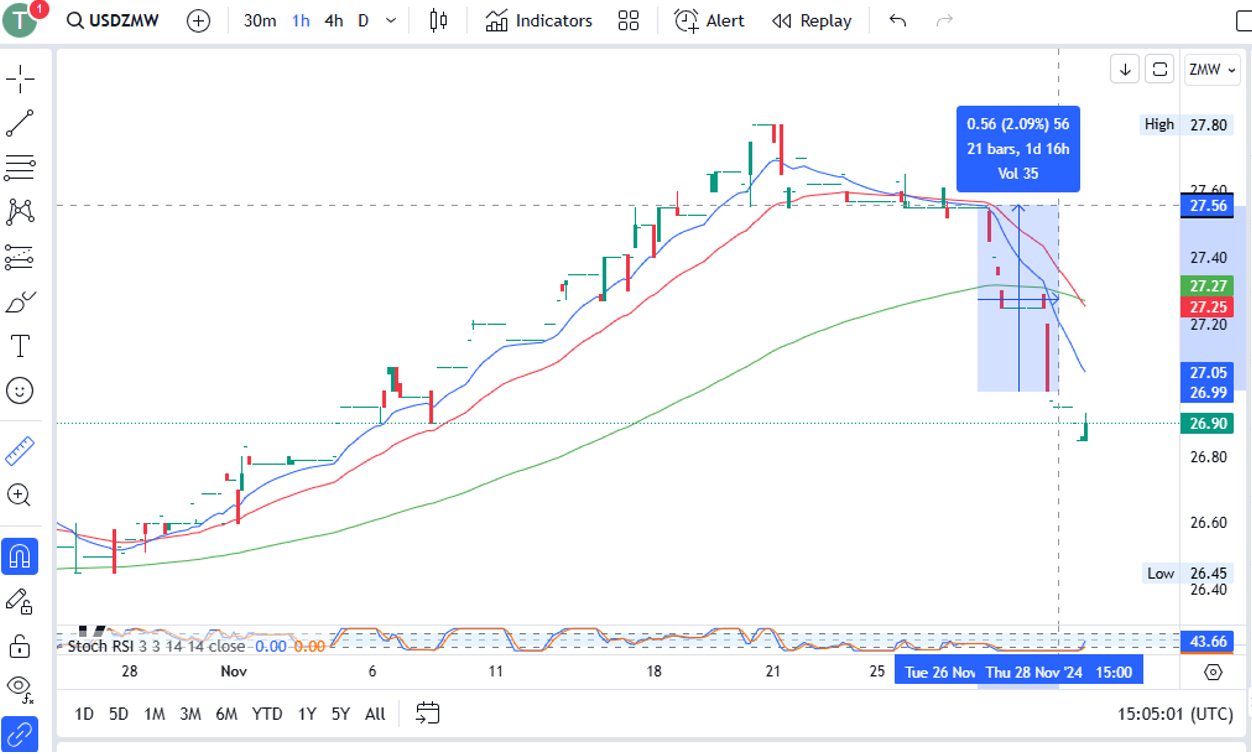CFD Trading In Zambia



Zambian traders now have the chance to buy and sell financial markets without actually owning the asset. And even better, they can do this by leveraging small amounts of kwacha (ZMW) to amplify potential gains. Welcome to the world of contracts for difference, or CFDs.
This beginner’s guide will unpack CFD trading in Zambia, taking you through the opportunities and risks, and walking you through Zambian taxes and regulations. We’ll also examine a CFD trade involving the kwacha.
Quick Introduction
- CFDs allow you access to stocks, indices, currencies, commodities, and even highly volatile cryptos, providing an opportunity to capitalize on trading markets beyond Zambia.
- CFD day traders often use leverage to open large positions with small deposits. However, CFDs are high-risk, and using leverage can amplify your potential gains and losses.
- Online trading is regulated by the Bank of Zambia (BoZ) and the Securities and Exchange Commission (SEC), but there are not yet specific regulations to govern CFD trading.
- There is no Capital Gains Tax on CFD trading in Zambia. Instead, profits will likely fall under personal income tax rates ranging from 20 – 37.5%.
Best CFD Brokers In Zambia
Through our hands-on tests, we've identified these 4 CFD providers as the best for traders in Zambia:
How Does CFD Trading Work?
Hypothetically speaking, you could buy shares in a top-performing company, such as Copperbelt Energy Corporation, a Zambian developer of sustainable energy infrastructure, without owning the underlying asset.
Instead of buying shares in the company, traders could buy or sell a CFD to speculate on price movements and potentially profit from rising and falling prices.
Using leverage means you could use a small investment to get much larger exposure to the market than the amount you initially deposited to open the trade.
In contrast to regions like Europe and Australia, where leverage caps at 1:30 for retail investors, Zambia imposes no such limits. This means you can access leverage as high as 1:1000 or more, offering the potential for huge gains but also massive losses.
What CFDs Can I Trade?
This will vary between brokers, but you may be able to trade CFDs spanning a wide range of markets:
- Index CFDs with Zambian exposure, including the AGUAX – American Beacon Frontier Markets Income Fund, MBDBX – Morgan Stanley variable insurance fund and JEMDX – JPMorgan Emerging Markets Debt Fund. However, these are very rare so you may prefer to focus on the US Dow Jones or UK FTSE 100.
- Forex CFDs on major currency pairs such as EUR/USD, GBP/USD, and USD/CAD, as well as minor and exotic currency pairs. You may also be able to the Zambian kwacha (ZMW) favored by many local traders, given its volatility, but keep in mind high spreads and slippage problems that could impact your profitability day trading.
- Stock CFDs like Copper Belt Energy (CEC), Zambian Sugar (ZSUG), and Zambian Breweries (ZAMBREW), though these aren’t widely available in our experience. You can mainly trade stocks from major hubs like the US, Europe and Australia, which offer superior liquidity.
- Commodity CFDs such as sugar, cotton, gold, silver and copper for opportunities linked to critical resources that can impact both the Zambian and global economy.
- Exchange-traded funds (ETFs) with Zambian exposure, such as SGI Pan Africa.
- Crypto CFDs such as Bitcoin, Ethereum, and altcoins can be traded as a simple means to speculate on the interest surrounding digital tokens without the actual difficulties associated with storing crypto tokens.
Is CFD Trading Legal In Zambia?
CFD trading is legal in Zambia under the proviso that brokers operate and are licensed by Zambia’s Securities and Exchange Commission (SEC).
Licensed brokers must keep segregated funds and submit regular reports to ensure they are fully compliant. They must also hold minimum capital funds of 500,000 Kwacha.
As Zambia’s regulatory environment is still developing, with limited rules specifically aimed at CFD trading, choose a reputable and well-regulated broker to ensure your funds are safe.
Is CFD Trading Taxed In Zambia?
There is no capital gains tax in Zambia, but CFD traders may be obliged to declare trading profits or losses as investment income on their tax returns and pay progressive personal income tax rates ranging from 20 – 37.5%.
Zambia’s tax year runs from 1 January to 31 December, with tax returns due to the Zambia Revenue Authority by 30 June the following year.
Given that there is limited publicly available guidance on how CFD trading will be treated for tax purposes in Zambia, I recommend consulting a tax professional who can help ensure you meet any obligations.
A CFD Trade In Action
To illustrate how CFD trading in Zambia can really work, here is a trade I executed on the USD/ZBW currency pair:
Technical Analysis
As a technical trader, I use the momentum bounce strategy for CFD trading on the daily timeframes or lower.
The momentum bounce strategy involves buying a CFD when its price rises or falls to a support level and then buying or selling it when it shows signs of reversing. The aim is to profit from short-term corrections or “bounces”.
Using the 20-day moving average as a support or resistance level, I go long or short when price action rebounds off this indicator.
I also use stochastics, the 200, 50, and 20-day simple moving averages, and trend lines to time trades and identify support and resistance levels.
I never risk more than 1% of my balance on any CFD trade and always use a stop-loss order to manage potential losses and set take-profit orders to exit the trade as soon as my target is reached.
Trade Entry And Exit
With the daily, 4-hour, and 1-hour timeframes in a downtrend, I identified support and resistance levels and decided to execute my trade on the 1-hour chart for a tighter entry.
Using confirmed and established support and resistance levels, I entered the trade at 27.50 as price action had just broken through the 20-day moving average and exited at 27.00 in profit.

Bottom Line
While CFD trading in Zambian is on the rise, allowing residents to access various financial markets, leverage carries significant risks due to market volatility.
If you’re considering trading CFDs, ensure you have a clear strategy and manage your capital effectively, never risking more than you can afford to lose.
To get going, turn to DayTrading.com’s selection of the top CFD providers.
Recommended Reading
Article Sources
The writing and editorial team at DayTrading.com use credible sources to support their work. These include government agencies, white papers, research institutes, and engagement with industry professionals. Content is written free from bias and is fact-checked where appropriate. Learn more about why you can trust DayTrading.com



